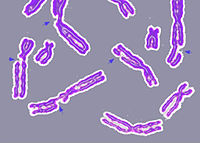
Photo from wikipedia
Double-strand breaks (DSBs) are considered to be one of the most harmful and mutagenic forms of DNA damage. They are highly toxic if unrepaired, and can cause genome rearrangements and… Click to show full abstract
Double-strand breaks (DSBs) are considered to be one of the most harmful and mutagenic forms of DNA damage. They are highly toxic if unrepaired, and can cause genome rearrangements and even cell death. Cells employ two major pathways to repair DSBs: homologous recombination (HR) and non-homologous end-joining (NHEJ). In plants, most applications of genome modification techniques depend on the development of DSB repair pathways, such as Agrobacterium-mediated transformation (AMT) and gene targeting (GT). In this paper, we review the achieved knowledge and recent advances on the DNA DSB response and its main repair pathways; discuss how these pathways affect Agrobacterium-mediated T-DNA integration and gene targeting in plants; and describe promising strategies for producing DSBs artificially, at definite sites in the genome.
Journal Title: Genes
Year Published: 2022
Link to full text (if available)
Share on Social Media: Sign Up to like & get
recommendations!